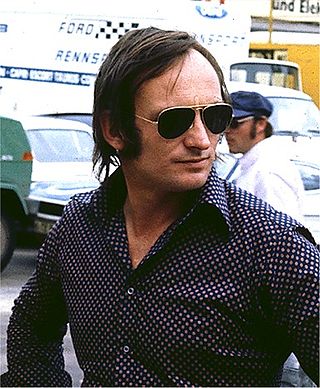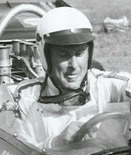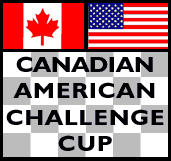This article needs additional citations for verification .(June 2022) |
The Surtees TS5 was a Formula 5000 racing car, designed, developed, and built by Surtees between 1969 and 1970. [1] [2] [3] [4] [5]
This article needs additional citations for verification .(June 2022) |
The Surtees TS5 was a Formula 5000 racing car, designed, developed, and built by Surtees between 1969 and 1970. [1] [2] [3] [4] [5]
The construction of the TS5 went back to an initiative by British racing car designer Roger Nathan. Nathan, who had developed a racing sports car under the name Costin Nathan together with Frank Costin in the second half of the 1960s, was looking for partners at the end of 1968 to develop a Formula 5000 racing car. Nathan wanted to enter this newly created racing series and needed a usable racing vehicle. He approached British racing car engineer Len Terry, who agreed to design a car. Terry made himself known primarily as the designer of the successful Lotus - Monoposto 33 and 38 made a name. He spent the year 1968 at Lola to develop the Formula 2 BMW T102 there. The third person involved was the former motorcycle and Formula One world champion, John Surtees. In 1968 Surtees was still a very active racing driver. He was a works driver for Honda and finished the Formula 1 Drivers' World Championship in seventh place overall.
Parallel to his commitments as a driver, Surtees had long since started to set up his own racing team, Team Surtees. After Nathan, Terry, and Surtees, the fourth participant in this project appeared at the end of 1968 with the American actor James Garner. Garner maintained a racing team under the name American International Racers and was looking for a vehicle to compete in the US Formula A series, the local counterpart to the British Formula 5000.
Terry designed and built the first four chassis in his small workshop in Poole, with logistical support from Surtees. Originally, the vehicles were to receive the designation Terry-Surtees TS5 for Formula 5000 and Garner TS5 for Formula A. But funding stalled, Nathan dropped out of the project and Garner had already sold his Lola T70 and CanAm - Lola T162 to fund his part of the project. It was only when John Surtees took over the project that the process got a reasonable technical and financial basis. Terry's four chassis were completed at the Surtees factory and three other cars were built entirely there.
In his design, Terry followed the slim construction that was already used in the Lotus 38. The race car had a monocoque, independent suspension, and a Hewland L.G.500 transmission. A 500 hp 5-liter V8 engine from Ford was originally intended as the engine. In the winter of 1968/1969, Garner team pilot Scooter Patrick took over the test drives with the prototype. When the two Garner TS5 were handed over to the Americans in March 1969, they equipped the car with Chevrolet V8 engines, which subsequently remained the main engines of this racing car. More test drives at Riverside were unpleasant. Scooter Patrick and Dave Jordan - who did the testing - complained about the poor handling of the cars. In addition, there were constant problems with the suspensions, which prompted James Garner to also get out of the project. The vehicles returned to England and the actor commissioned new racing vehicles from Dan Gurney's AAR Eagle.
In addition to building the remaining vehicles, John Surtees also took over their racing operations and renamed the vehicles Surtees TS5. Thus began the long typology of Surtees racing cars under the abbreviation TS for Team Surtees.
The TS5 made its racing debut in April 1969 at Oulton Park. It was the opening race of the 1969 European Formula 5000 Championship and also the first race in this newly established series. John Surtees had brought the Garner back to Europe and used the cars, still with Chevrolet engines, under his own team leadership. David Hobbs, Andrea de Adamich, and Trevor Taylor were committed as drivers. In contrast to the test experiences in the USA, the cars were fast in practice and did not have any technical problems. David Hobbs set the fastest lap time of 1:30.6 in qualifying and put his TS5 on pole position. Andrea de Adamich finished fourth in training but was unable to take part in the race because he had an accident just before the end of training and severely damaged his car. In the race, Hobbs only had to beat Peter Gethin in the McLaren M10A and achieved a podium finish in the first race.
At the third round of the season at Brands Hatch, there was the second pole position, this time secured by Trevor Taylor. A defective clutch also prevented its launch. Hobbs celebrated the first race victory at the sixth round of the season at Mondello Park, where he was waved off as the winner after 84 laps in front of Mike Hailwood in the Lola T142 and Alan Rollinson on a Brabham BT30.
A winning streak was followed by Trevor Taylor, who won back-to-back races at Koksijde, Zandvoort, Snetterton, and Hockenheim. However, he could not secure the overall ranking; this went to Peter Gethin, preferably by eliminating results from Taylor.
In 1970, the first win of the season was not until the ninth race, when Trevor Taylor won ahead of Peter Gethin in the revised McLaren M10 and Frank Gardner in the Lola T190. During the course of the season, Surtees withdrew from Formula 5000, since the entry into the Formula 1 World Championship was already pending, which required the full attention of the team. One car, a TS5A with chassis number 008, was sold to Irishman Alan Rollinson, who had little success with the car and switched to a Lotus 70 before the end of the season.
At the end of the year, all TS5 and TS5A were sold. Surtees re-entered the Formula 5000 championship as a factory in 1971 with the successor model, the TS8.
The American racing driver Mike Goth acquired the TS5 with the chassis number 005 in the spring of 1969 and used it in the championship from the sixth race of the season at Elkhart Lake. Right at the debut race, which consisted of three sprint races and the resulting overall standings, he finished third behind Tony Adamowicz in the Eagle Mk5 and McLaren driver John Cordts. Surtees accepted the great logistical challenge and also entered works cars in Formula A. For this purpose, the vehicles had to be shipped again and again by air freight be transported back and forth between the UK and the US; this was also a not inconsiderable financial effort. In the same race as Goth, David Hobbs also started in the works car, but dropped out on the second lap due to a defect. After Hobbs then came second in the second race, the race at Lime Rock, and the third race, the Minnesota Grand Prix at Brainerd, saw the first race win for a TS5 in the USA. Four more wins of the season followed for Hobbs, including a double at Mont-Tremblant when he won ahead of Andrea de Adamich.
As in Europe, Surtees could not win the overall championship standings in the USA, despite strong races and successes that could be counted, since the team entered the series too late in the year and Tony Adamowicz's point advantage in the Eagle was therefore uncatchable.
In 1970, Surtees' involvement in the US factory ended.
In 1970 the TS5 was revised and became the TS5A. There were detailed improvements to the suspensions, the fuel tanks, and the engine lubrication. The braking system was improved and switched from the LG500 to the Hewland DG300 gearbox. There is different information about the number of pieces produced. While John Surtees spoke of 15 vehicles built, only ten TS5A can be fixed despite the confusing chassis stories. The acquisition of a copy by the British racing car manufacturer Trojan is secured. The McLaren M10 was manufactured at Trojan and a TS5A served as a technological example. A completely impossible process today in racing car construction.
The TS5A was driven by various private drivers until the late 1970s. The American Howie Fairbanks drove a TS5A in 1978 in the SCCA series.
If the assignment of the chassis numbers is easy with the TS5, this is much more difficult with the TS5A. This is mainly due to the lack of assignment of the cars delivered to Royal American Competition Enterprises Fred Opert Racing and Doug Hooper, which leads to great potential for confusion. Nevertheless, an attempt should be made here to assign the numbers.
Mike Goth also contested the Tasman Series races of that year in January and February 1970 in his TS5, chassis 005. With ten points he finished eighth in the championship.

John Surtees, was a British Grand Prix motorcycle road racer and Formula One driver. On his way to become a seven-time Grand Prix motorcycle World Champion, he won his first title in 1956, and followed with three consecutive doubles between 1958 and 1960, winning six World Championships in both the 500 and 350cc classes. Surtees then made the move to the pinnacle of Motorsport, the Formula 1 World Championship, and in 1964 made motor racing history by becoming the F1 World Champion. To this day Surtees remains the only person to have won World Championships on both two and four wheels. He founded the Surtees Racing Organisation team that competed as a constructor in Formula One, Formula 2 and Formula 5000 from 1970 to 1978. He was also the ambassador of the Racing Steps Foundation.

The Cooper Car Company is a British car manufacturer founded in December 1947 by Charles Cooper and his son John Cooper. Together with John's boyhood friend, Eric Brandon, they began by building racing cars in Charles's small garage in Surbiton, Surrey, England, in 1946. Through the 1950s and early 1960s they reached motor racing's highest levels as their mid-engined, single-seat cars competed in both Formula One and the Indianapolis 500, and their Mini Cooper dominated rally racing. The Cooper name lives on in the Cooper versions of the Mini production cars that are built in England, but is now owned and marketed by BMW.

Christopher Arthur Amon was a New Zealand motor racing driver. He was active in Formula One racing in the 1960s and 1970s, and is widely regarded as one of the best F1 drivers never to win a championship Grand Prix. His reputation for bad luck was such that fellow driver Mario Andretti once joked that "if he became an undertaker, people would stop dying". Former Ferrari Technical Director Mauro Forghieri stated that Amon was "by far the best test driver I have ever worked with. He had all the qualities to be a World Champion but bad luck just wouldn't let him be".
The Surtees Racing Organisation was a race team that spent nine seasons as a constructor in Formula One, Formula 2, and Formula 5000.
Lola Cars International Ltd. was a British race car engineering company in operation from 1958 to 2012. The company was founded by Eric Broadley in Bromley, England, before moving to new premises in Slough, Buckinghamshire and finally Huntingdon, Cambridgeshire, and endured for more than fifty years to become one of the oldest and largest manufacturers of racing cars in the world. Lola Cars started by building small front-engined sports cars, and branched out into Formula Junior cars before diversifying into a wider range of sporting vehicles. Lola was acquired by Martin Birrane in 1998 after the unsuccessful MasterCard Lola attempt at Formula One.
Robert Brett Lunger is an American racecar driver.

Peter Kenneth Gethin was a British racing driver from England. He participated in 31 World Championship Formula One Grands Prix, debuting on 21 June 1970. He won the 1971 Italian Grand Prix in the fastest average speed in Formula One history, but this was his only podium finish. Gethin also participated in numerous non-Championship Formula One races, winning the 1971 World Championship Victory Race and the 1973 Race of Champions.
Trevor Taylor was a British motor racing driver from England.

Graham McRae was a racing driver from New Zealand. He achieved considerable success in Formula 5000 racing, winning the Tasman Series each year from 1971 to 1973, and also the 1972 L&M Continental 5000 Championship in the United States.

The Canadian-American Challenge Cup, or Can-Am, was an SCCA/CASC sports car racing series from 1966 to 1987.

Formula 5000 was an open wheel, single seater auto-racing formula that ran in different series in various regions around the world from 1968 to 1982. It was originally intended as a low-cost series aimed at open-wheel racing cars that no longer fit into any particular formula. The '5000' denomination comes from the maximum 5.0 litre engine capacity allowed in the cars, although many cars ran with smaller engines. Manufacturers included McLaren, Eagle, March, Lola, Lotus, Elfin, Matich and Chevron.

The Honda RA300 was a Formula One racing car produced by Honda Racing, and introduced towards the end of the 1967 Formula One season. It retained the same V12 engine as the preceding RA273 car, but the chassis was designed by Lola's Eric Broadley and based on a previous Lola Indianapolis 500 car, the T90. Internally, Lola designated the RA300 the T130. This collaboration resulted in the machine quickly being dubbed the "Hondola" by the motorsports press.
Eric Harrison Broadley MBE was a British entrepreneur, engineer, and founder and chief designer of Lola Cars, the motor racing manufacturer and engineering company. He was arguably one of the most influential automobile designers of the post-war period, and over the years Lola was involved with many high-profile projects in Formula One, IndyCar, and sports car racing. Broadley sold Lola to Martin Birrane in 1999.

The Lola T332 was a race car designed and built by Lola Cars for use in Formula 5000 racing and made its racing debut in 1973. The T332 was successful around the globe with race victories in places such as Australia, the United Kingdom, New Zealand and the United States. The Lola commonly used the 5.0-litre Chevrolet V8 engine, though some competitors in Australia and New Zealand used the slightly cheaper and less powerful Australian made 5.0-litre Repco Holden V8.

The March 701 is a Formula One racing car model, designed by Robin Herd with Peter Wright, and built by March Engineering. The 701 was March's first Formula One design – following their one-off March 693P Formula Three prototype of 1969 – and was designed and built in only three months. The March 701 made its race debut a month after its public unveiling, at the 1970 South African Grand Prix. In total, eleven 701s were constructed, with March supplying many privateer entrants as well as their own works team. The 701's career started well, March drivers taking three wins and three pole positions from the car's first four race entries, but lack of development through the 1970 Formula One season resulted in increasingly poor results as the year wore on. The 701 was superseded by the March 711 in 1971, and made its last World Championship race appearance at the 1971 Italian Grand Prix.
The Surtees TS8 is an open-wheel Formula 5000 race car, designed, developed and built by Surtees in 1971, and is closely based on their 1970 Surtees TS7 Formula One car. It featured a slightly longer wheelbase, and a 302 cu in (4,950 cm3) Chevrolet small-block engine, producing 465 hp (347 kW), which was a stress member of the chassis, and drove the rear wheels through a Hewland D.G. 300 five-speed manual transmission. It won 6 races in total; 4 races with Mike Hailwood, and 2 races for Alan Rollinson. Hailwood eventually finished second-place as runner-up in the championship, with 58 points. It also competed in a bunch of non-championship Formula One Grand Prix races; with its best result being a 4th-place finish Oulton Park in 1971, being driven by Alan Rollinson.
Leonard E. Terry was an English racing car designer and engineer, known for his work with Lotus, BRM and Eagle. He also designed chassis for many other teams, including ERA and Aston Martin and produced his own car in which he competed.
The Lola T100 is a Formula 2 single-seater entered by German BMW team for the 1967 German Grand Prix, the seventh round of the 1967 Formula One World Championship. Designed by British manufacturer Lola Cars, led by engineer Eric Broadley, the T100 was raced by Britons David Hobbs and Brian Redman. A version adapted to the technical regulations of Formula 1 was also driven by German Hubert Hahne.

John Oliver Gunn Jr., also referred to by the nickname Johnnie, was an American race car driver from Yanceyville, North Carolina.
The Eagle Mk.5 was a race car designed and built by Eagle for use in Formula 5000 racing and made their racing debut in 1968, and competed until 1972. The Eagle Mk.5 was powered by the commonly used 5.0-liter Chevrolet V8 engine.